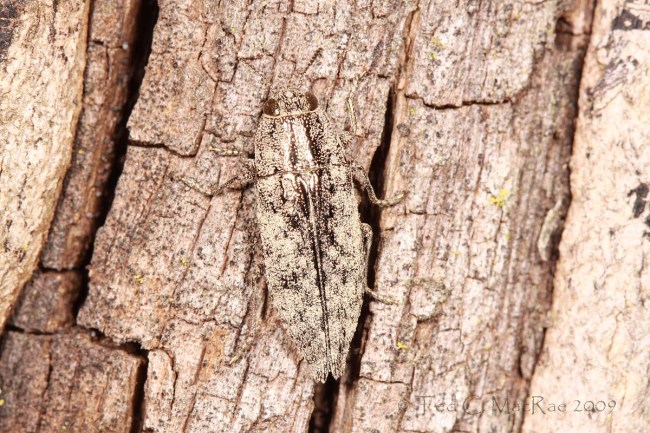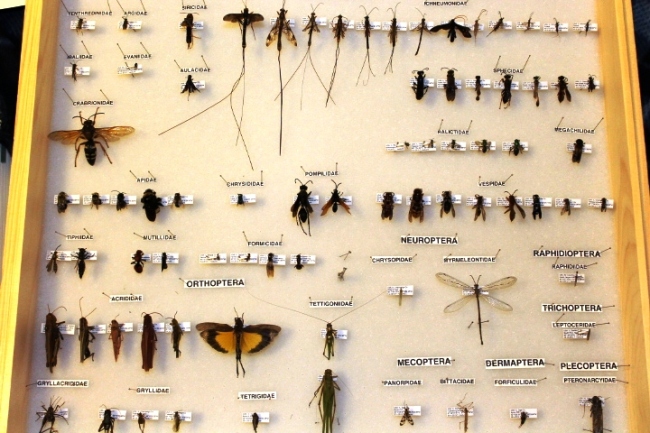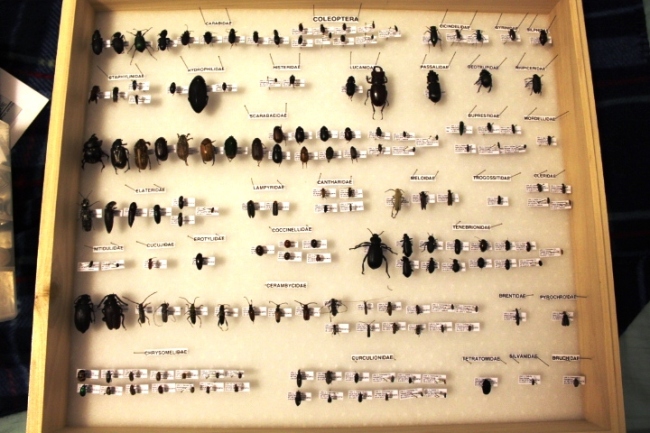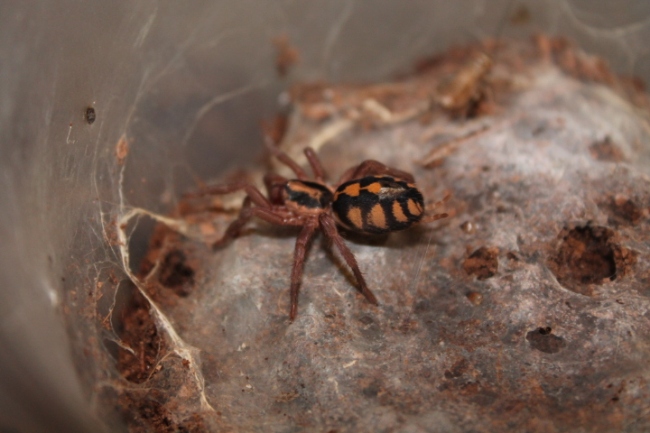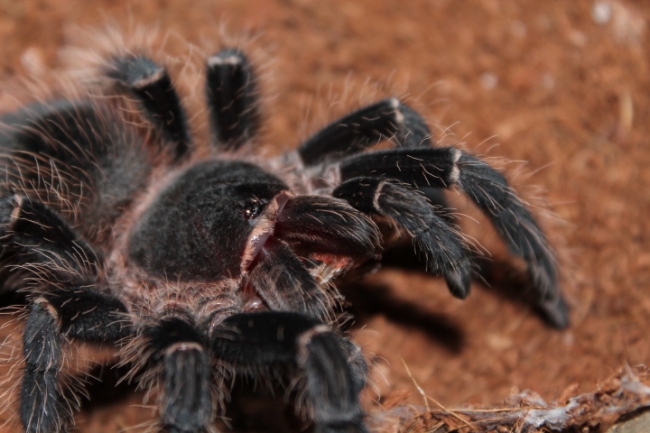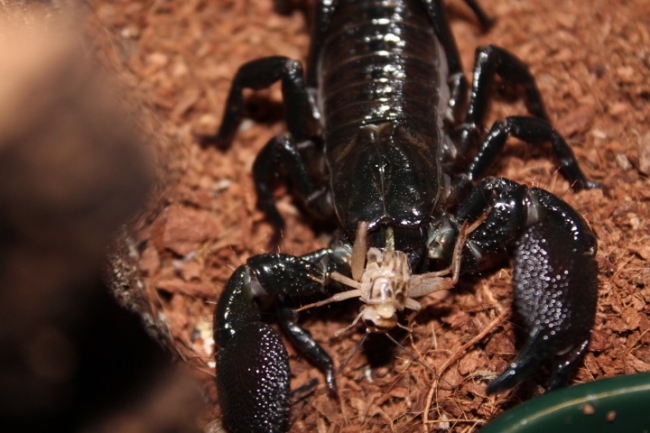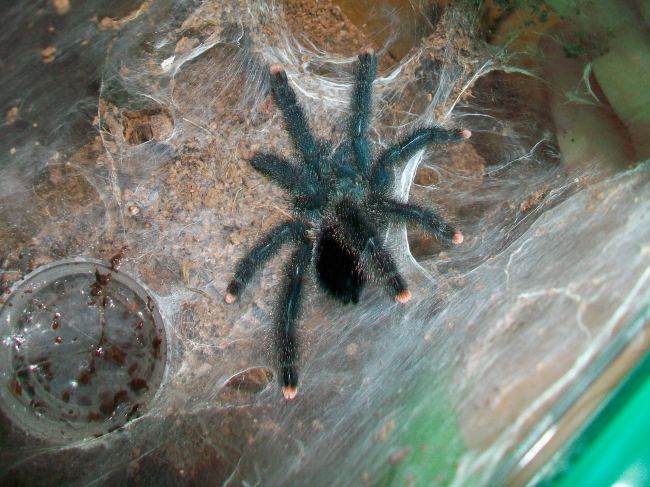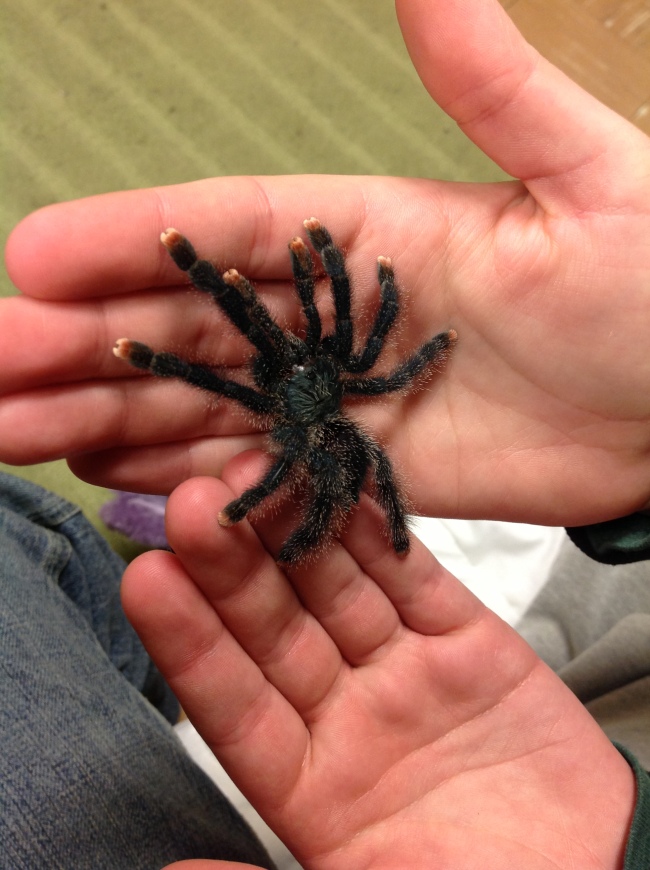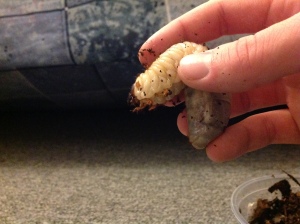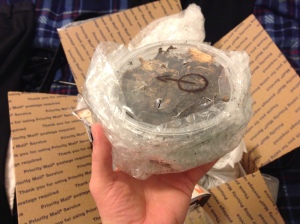Tarantula Tuesday (Long Overdue): Brazilian Dwarf Blue Beauty
I have been remiss in giving you all the 8-legged goodness you want, so this week I’m going to feature a species that just recently came over to the United States and was actually only classified in 2009. This amazing species is known as the Brazilian dwarf blue beauty, Oligoxystre diamantinensis.
This colorful dwarf species is easy to care for, with humidity requirements above 50% and temperatures in the 70’s F being enough to keep it happy. This simple care is offset though by their attitude and the hefty price tag. Slings (spiderlings) less than 1 inch (2.5 cm) have been going for upwards of $100 very easily. Hopefully the prices will drop as they become more common due to breeding efforts by dedicated individuals. Despite not growing much larger than 4 inches (10 cm), these spiders are vicious predators, being able to take down prey as large as they are.
Being so new to the U.S., there isn’t too much information on them yet, but the simple care means that this is another easy tarantula to keep and care for.
I know this one is on my wish list!
Winter Brings Dreams of Collecting
As the snow continues to fall here in central Illinois, all I can think of is going out and collecting again. The beetles I hunt for have all gone to ground and will stay there until it begins to warm up again. I’ve even been having dreams of collecting the past couple nights, though those could be due to me spending large amounts of time on Ted MacRae’s extremely informative blog, Beetles in the Bush, especially on his posts about jewel beetles (Family Buprestidae).
Last night’s dream had me wandering along the edge of a wooded area and finding a tree that had been knocked down recently. As I excitedly walked up to the tree, I found dozens of species of buprestids! Realistically this would never happen, but a guy can dream, right?
Besides all this dreaming, I’ve begun planning for what is looking to be one heck of a field/collecting season. BugGuide has been my friend as always in helping me make up a wish list of species that I’m hoping to collect and showing me where they can be found. The next steps will involve finding places to collect at and figure out what trees I should be looking for. I will likely be confined to the Midwest for most of the season, but I may be able to swing down to the Southwest in the spring (fingers crossed!).
And finally, because I can’t leave you all without a picture of some sort, here is a picture from Ted MacRae of the beautifully cryptic buprestid, Dicerca obscura.
When a Collection Comes Together
I’m an avid insect collector. As soon as it starts getting warm, I run out into the woods with my net and backpack of vials and other miscellaneous items. It’s always an enjoyable excuse to get out into nature to get some fresh air.

Though things can go wrong when you sink into water that goes over your boot tops (photo courtesy of Ellie Moen)
It really gets fun when my fellow entomophiles join me in the woods and we can really get the collecting going. We all catch interesting insects and trades undoubtedly occur as people catch insects from certain highly sought after families.
As a graduate student, I just finished taking an insect taxonomy course, and one of the course requirements was that I make an insect collection. Considering that I had been collecting insects and putting them in my freezer for two years, I was pretty set. The issue was that I hadn’t really pinned up all that much yet (and don’t even get me started on labeling…). But I knew I had to do it and I knew that I was going to enjoy it.
After spending innumerable hours working on it, I was finally able to turn in my collection. I did go a bit over what the requirements were, but I was just trying to empty my freezer and get things pinned up. And here it is:
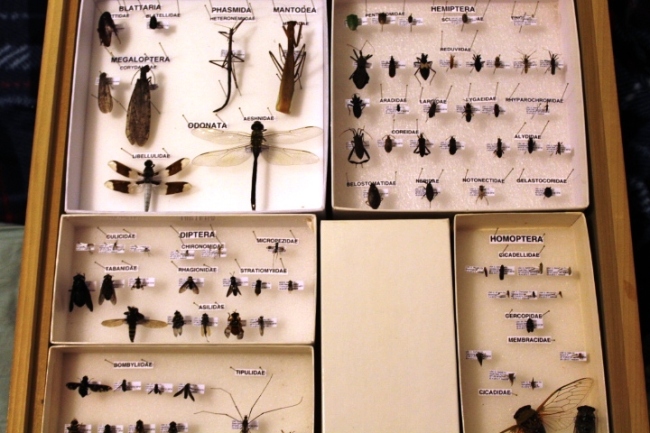
Box #2, containing assorted orders. Homoptera is no longer an accepted order name, but it was permissible for this class’ collection
And saving best for last…
And as an added bonus, my freezer is now almost completely devoid of insects (which my roommate is super happy about)!
New Camera!
So I’m very excited to say that I got a new camera recently. I have been using a simple point-and-shoot for the last 5 years and I wanted to mix things up and get a good camera. After talking with several people about it, I decided to get the Canon Rebel T3. I’m looking forward to taking insect/arachnid pictures this next year once winter decides to call it quits.
It’s going to take some getting used to, but I’m eventually hoping to take some high quality photos (like what you see here and here). For now, I’m reading everything I can and taking lots of pictures of tarantulas and other arachnids to test things out.
Here are a few other photos!
I’m sure major photo gurus are cringing at some of my photos, but it will get better. All it takes is practice and reading, which is true of just about anything in life.
Tarantula “Tuesday”: Metallic Pink Toe
I know this isn’t the normal Tarantula Tuesday post (mainly because it’s Thursday), but I can’t leave you all without another tarantula species right? So this week, we will talk about the metallic pink toe (Avicularia metallica).
Tarantulas in the genus Avicularia are arboreal, meaning that they spend the majority of their time living in the trees. They are fantastic climbers and can climb up glass without a problem. There is always a risk of falling, but arboreal tarantulas lose their grip less frequently and seem to be more resistant to falls than their terrestrial counterparts.
Avics are generally considered to be a good beginner arboreal tarantula and the A. metallica and A. avicularia are both pretty easy to find. Care is a bit more difficult than other beginner species (such as the Brachypelma that I highlighted over the last two weeks), but it is still a fairly easy tarantula to keep.
To start things off, you need an enclosure with more height than floor space, so your Avic can climb around to its little open heart’s content. I personally keep mine in a snack container that I got for a couple dollars from Walmart (kind of like these). Once they have that space, you can decorate with cork bark, branches, really just about anything, as long as it’s clean. You can also choose to put nothing in and your Avic will web it’s own home onto a wall.
Avics usually tolerate handling well, though they can be a bit skittish. Biting is rare since they would rather just flee. But one thing that they commonly do is shoot their frass (fancy entomology word for poop). My A. metallica has quite the range and can fire frass well over a foot. She does that every time I get her out, but quickly calms down and just wanders.
To care for Avics, you have to keep two things in mind: humidity has to be kept fairly high (~70-80%) and good ventilation is an absolute must have. If there isn’t good ventilation, then the stagnant air in the enclosure will eventually suffocate your tarantula or cause mold to grow in its book lungs. They do like it on the warmer side, with temperatures in the mid-70s to mid-80s being ideal, but not necessary.
More info about the A. metallica and other Avics can be found here
References:
“Tarantula and Scorpion Handler’s Blog: Avicularia Tarantula Caresheet.” Tarantula and Scorpion Handler’s Blog: Avicularia Tarantula Caresheet. N.p., 31 Mar. 2011. Web. <http://tarantula-and-scorpion-handlers-blog.blogspot.com/2011/03/avicularia-tarantula-caresheet.html>.
Schultz, Stanley A., and Marguerite J. Schultz. The Tarantula Keeper’s Guide. Hauppauge, NY: Barron’s Educational Series, 1998. Print.
The Arrival
I’m a bit behind on this post, but I couldn’t resist. While my posts have been pretty focused on tarantulas right now, I can mix it up with a cool post about beetles.
Breaking open rotting logs in forested areas is a favorite past-time of mine. You never really know what you will find. Something that is in almost every log is beetle larvae. A variety of larvae can be found, from click beetle to stag beetle. I’ve tried casually keeping larvae I’ve found before, but my success rate has been pretty low (with flat bark beetles being my only real success). But then I came across a forum for beetles, where people keep native and exotic beetles and beetle larvae. The clincher was when I got my beetle breeding and rearing book (seen in “In Pursuit For Knowledge“). The book proved to be an extremely good read and I learned an unbelievable amount about keeping beetles and beetle larvae.
But after reading and reading and reading, I was finally ready to take the plunge into serious beetle keeping (cue dramatic music). Now a very glaring question arises. Where the heck do I get adult beetles or larvae? Certain families can be readily found around here, but after several previous attempts with smaller species, I wanted to start off with a bang. I scoured beetleforum.net until I came across an interesting species that was considered to be a good beginning species. Sounds good right? I figured I would get a couple larvae, rear them out, and get some decent sized beetles that I would breed and sell the larvae off. But after I bought the larvae and they arrived, I was in for quite the surprise.
These larvae were massive. To be honest, I really didn’t know what to expect, but it wasn’t something this large! I was extremely excited and quickly placed the sexed larvae (that’s right, you can sex them before adulthood as long as they are final instar) into a large enclosure with more than enough rotting wood for them to feast on after their long(ish) journey.
Shipping larvae is pretty sweet. You just place them in a cup of some sort with substrate/food, put some padding in the box and around the cups and send them off. And let me tell you, the guy who sent them to me did a heck of a job with the packing. It’s cold here, but priority shipping is always and option with beetle larvae. They don’t have to be shipped express, so that saves you some money right off the bat, and you get to recycle those pesky old deli cups!
Oh, I forgot to mention what species I’m keeping? Silly me. They may not look particularly exciting now (besides the whole massive part), but in a few months they will. My first beetle species to keep is…Allomyrina dichotoma, aka, the Samurai helmet beetle!
For more information on A. dichotoma, check out these links:
http://carnivoraforum.com/topic/9680884/1/
https://www.facebook.com/media/set/?set=a.435138719898779.102520.430512957028022&type=3
I’m really hoping to get lucky with theses guys and get some breeding adults. I would only have one male and one female, but you gotta start somewhere, right?

